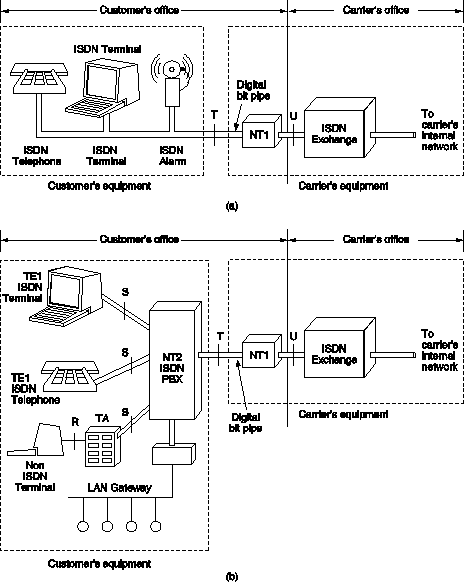|
|
|
|
Anticipating user demand for end-to-end digital services the world's
telephone companies agreed in 1984 under the auspices of CCITT to build a
new, fully digital, circuit-switched telephone system by the early part
of the 21st century. This system was called ISDN (Integrated Services
Digital Network) and its primary goal was to integrate the voice and
nonvoice services. It is already available in many locations and its
use is growing slowly.
2.5.1. ISDN Services
The key ISDN service will continue to be voice but with many enhanced features.
Some of them are:
The key idea behind ISDN is that of the digital bit pipe between the customer and the carrier through which bits flow in both directions. Whether the bits originate from a digital telephone, a digital terminal, a digital facsimile machine, or some other device is irrelevant.
The digital bit pipe can support multiple independent channels by time division multiplexing of the bit stream. Two principal standards for the bit pipe have been developed:
Normal configuration for a home consists of a network terminating device NT1 (Fig. 2-41(a)) placed on the customer's premises and connected to the ISDN exchange in the carrier's office using the twisted pair previously used to connect the telephone. The NT1 box has a connector into which a bus cable can be inserted. Up to 8 ISDN telephones, terminals, alarms, and other devices can be connected to the cable. From the customer's point of view, the network boundary is the connector on NT1.

Fig. 2-41. (a) Example ISDN system for home use. (b) Example ISDN
system
with a PBX for use in large businesses.
For large businesses, the model of Fig. 2-41(b) is used. There is a device NT2 called PBX (Private Branch eXchange - conceptually the same as an ISDN switch) there connected to NT1 and providing the interface for ISDN devices.
CCITT defined four reference points (Fig. 2-41):
The ISDN bit pipe supports multiple channels interleaved by time division multiplexing. Several channel types have been standardized:
It is not allowed to make arbitrary combination of channels on the digital pipe. Three combinations have been standardized so far:

Fig. 2-42. (a) Basic rate digital pipe. (b) Primary rate digital pipe.
Because ISDN is so focused on 64 kbps channels, it is referred to as
N-ISDN (Narrowband ISDN), in contrast to broadband ISDN (ATM).
2.5.4. Perspective on N-ISDN
N-ISDN was an attempt to replace the analog telephone system with a digital one. Unfortunately, the standardization process was too long and regarding to the technology progress in this area, once the standard was finally agreed, it was obsolete.
N-ISDN basic rate is too low so for home as for business today. N-ISDN may be partly saved, but by an unexpected application: Internet access. Various companies now sell ISDN adapters that combine the 2B + D channels into a single 144 kbps digital channel. Many Internet providers also support these adapters. So the people can access Internet over a 144 kbps digital link, instead of a 28.8 kbps analog modem link and for affordable price that may be a niche for N-ISDN for the next few years.